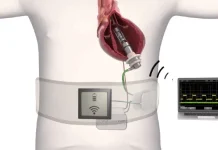CVRx announced the publication of post-market data highlighting long-term, sustained benefits with its Barostim device.
Minneapolis-based CVRx published results from the BeAT-HF trial in the European Journal of Heart Failure. Data supported Barostim treatment in heart failure patients with reduced ejection fraction.
Related: QT imaging’s breast imaging system proves as effective as mammography
Barostim delivers electrical pulses to baroreceptors in the wall of the carotid artery. These activate the body’s baroreflex, triggering an autonomic response to the heart. CVRx designed the therapy to restore balance to the autonomic nervous system, reducing the symptoms of heart failure. The system holds FDA breakthrough device designation and FDA approval for use in heart failure patients in the U.S. It also holds CE mark approval for heart failure and resistant hypertension in Europe.
CVRx previously announced some of the data from this study as part of an expanded FDA labeling for Barostim granted in December.
“Publication of these data from the post-market phase of BeAT-HF in this prestigious peer-reviewed journal allows for more effective dissemination of the long-term results of this important trial and the positive symptomatic impact of Barostim on patients with heart failure,” said Kevin Hykes, president and CEO of CVRx. “Additionally, we are pleased at the favorable physician response to new abstracts released at THT in Boston on March 5, 2024, that show a reduction in additional heart failure interventions in patients with Barostim, as well as specific patient-centered benefits at long-term follow-up.”
A look at the outcomes with the CVRx Barostim system
The company reported no statistically significant difference in the primary endpoint of cardiovascular death and heart failure hospitalization. This demonstrates that the benefits of the therapy don’t increase the long-term risk to patients.
CVRx said that patients with Barostim plus guideline-directed medical therapy had sustained and significant symptomatic improvements at up to two years. They also had a 34% reduced likelihood of all-cause death or the need for a left ventricular assist device (LVAD) implantation or heart transplant. This suggests a favorable effect from Barostim.
Other analyses of the data, presented last month, showed a 74% reduced risk of receiving advanced heart failure interventions at long-term follow-up. CVRx also saw sustained and significant improvements in quality of life scores.
Additionally, two new post-hoc analyses of the BeAT-HF trial data, presented on March 5, 2024 at Technology in Heart Failure Therapeutics (THT) 2024 in Boston, suggest additional important benefits of Barostim.
“We are grateful to the BeAT-HF executive steering committee and the many investigators involved in the trial for their dedication to advancing the science supporting this therapy,” Hykes said. “We look forward to the generation of additional evidence about Barostim from the BeAT-HF trial, as well as from real-world experience through our REBALANCE post-market registry and investigator-initiated research.”






